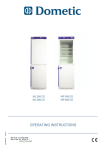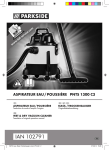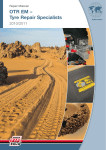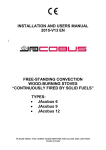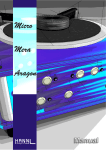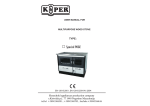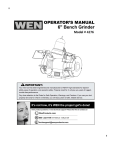Download Proxxon 38060 Use and Care Manual
Transcript
Disc sander TSG 250/E Manual Operating Instructions Disc sander TSG 250/E 1. 2. 3. 3.1. 4. 4.1. 4.2. 4.3. 5. 5.1. 5.2. 5.3. 5.4. 5.5. 6. 6.1. 6.2. 6.3. 7. 8. 9. 10. 11. Introduction ………………………………………………………………………………………………………………… 2 GROUNDING INSTRUCTIONS ………………………………………………………………………………………… 2 General safety instructions ………………………………………………………………………………………………… 3 Additional safety instructions for sander ………………………………………………………………………………… 4 Description of disc sander TSG 250/E …………………………………………………………………………………… 4 Scope of delivery:…………………………………………………………………………………………………………… 5 Legend (Fig. 1) ……………………………………………………………………………………………………………… 5 Technical data ……………………………………………………………………………………………………………… 5 Commissioning the device ………………………………………………………………………………………………… 5 Setting up your disc sander: ……………………………………………………………………………………………… 5 Removing and attaching the sanding table (Fig. 3): …………………………………………………………………… 6 Check and set angle display (Fig. 4): …………………………………………………………………………………… 6 Setting the sanding table angle (Fig. 5): ………………………………………………………………………………… 6 Connecting the vacuum cleaner (Fig. 6): ………………………………………………………………………………… 7 Working with the disc sander TSG 250/E: ……………………………………………………………………………… 7 Notes on sanding speed …………………………………………………………………………………………………… 7 Working with the angle stop (Fig. 8):……………………………………………………………………………………… 8 Adhering or replacing the sanding discs (Fig. 9): ……………………………………………………………………… 8 Accessories: ………………………………………………………………………………………………………………… 8 Accessories for wet sanding and cutting of glass, stone and tiles: …………………………………………………… 9 Care and maintenance …………………………………………………………………………………………………… 9 Spare parts list ……………………………………………………………………………………………………………… 9 Exploded drawing ………………………………………………………………………………………………………… 11 1. Introduction 2. Grounding instructions Dear Customer! 1. All grounded, cord-connected tools: The use of these instructions In the event of a malfunction or breakdown, grounding provides a path of least resistance for electric current to reduce the risk of electric shock. This tool is equipped with an electric cord having an equipment-grounding conductor and a grounding plug. The plug must be plugged into a matching outlet that is properly installed and grounded in accordance with all local codes and ordinances. Do not modify the plug provided -- if it will not fit the outlet, have the proper outlet installed by a qualified electrician. Improper connection of the equipment-grounding conductor can result in a risk of electric shock. The conductor with insulation having an outer surface that is green with or without yellow stripes is the equipment-grounding conductor. If repair or replacement of the electric cord or plug is necessary, do not connect the equipment-grounding conductor to a live terminal. Check with a qualified electrician or service personnel if the grounding instructions are not completely understood, or if in doubt as to whether the tool is properly grounded. Use only 3-wire extension cords that have 3prong grounding plugs and 3pole receptacles that accept the tool's plug. • makes it easier to become acquainted with the device, • prevents malfunctions due to improper handling, and • increases the service life of your device. Always keep these instructions close to hand. Only operate this device with exact knowledge of it and comply with the instructions. PROXXON will not be liable for the safe function of the device for: • handling that does not comply with the usual intended use, • other application uses that are not stated in the instructions, • disregard of the safety regulations, You will not have any warranty claims for: • operating errors, • lack of maintenance. For your safety, please comply with the enclosed safety regulations without fail. Only use original PROXXON spare parts. All rights reserved for further developments within the meaning of technical progress. We wish you much success with the device. Repair or replace damaged or worn cord immediately. 2. Grounded, cord-connected tools intended for use on a supply circuit having a nominal rating less than 150 volts: This tool is intended for use on a circuit that has an outlet that looks like the one illustrated in Sketch A in Figure 10. The tool has a grounding plug that looks like the -2- plug illustrated in Sketch A in Figure 10. A temporary adapter, which looks like the adapter illustrated in Sketches B and C, may be used to connect this plug to a 2-pole receptacle as shown in Sketch B if a properly grounded outlet is not available. The temporary adapter should be used only until a properly grounded outlet can be installed by a qualified electrician. The green-colored rigid ear, lug, and the like, extending from the adapter must be connected to a permanent ground such as a properly grounded outlet box. Fig. 10: Grounding methods METAL SCREW COVER OF GROUNDED OUTLET BOX GROUNDING PIN <B> <A> ADAPTER <C> GROUNDING MEANS GROUNDING PIN <D> 3. General safety instructions 1. KEEP GUARDS IN PLACE and in working order. 2. REMOVE ADJUSTING KEYS AND WRENCHES. Form habit of checking to see that keys and adjusting wrenches are removed from tool before turning it on. 3. KEEP WORK AREA CLEAN. Cluttered areas and benches invite accidents. 4. DON'T USE IN DANGEROUS ENVIRONMENT. Don't use power tools in damp or wet locations, or expose them to rain. Keep work area well lighted. 5. KEEP CHILDREN AWAY. All visitors should be kept safe distance from work area. 6. MAKE WORKSHOP KID PROOF with padlocks, master switches, or by removing starter keys. 7. DON'T FORCE TOOL. It will do the job better and safer at the rate for which it was designed. 8. USE RIGHT TOOL. Don't force tool or attachment to do a job for which it was not designed. 9. USE PROPER EXTENSION CORD. Make sure your extension cord is in good condition. When using an extension cord, be sure to use one heavy enough to carry the current your product will draw. An undersized cord will cause a drop in line voltage resulting in loss of power and overheating. Table 1 shows the correct size to use depending on cord length and nameplate ampere rating. If in doubt, use the next heavier gage. The smaller the gage number, the heavier the cord.Exception No. 1: The reference to the table and the table itself may be omitted if a statement indicating the appropriate gage and length is incorporated into the instruction.Exception No. 2: The information regarding extension cords need not be provided for a permanently connected tool. 10. WEAR PROPER APPAREL. Do not wear loose clothing, gloves, neckties, rings, bracelets, or other jewelry which may get caught in moving parts. Nonslip footwear is recommended. Wear protective hair covering to contain long hair.Exception: The reference to gloves may be omitted from the instructions for a grinder. 11. ALWAYS USE SAFETY GLASSES. Also use face or dust mask if cutting operation is dusty. Everyday eyeglasses only have impact resistant lenses, they are NOT safety glasses. 12. SECURE WORK. Use clamps or a vise to hold work when practical. It's safer than using your hand and it frees both hands to operate tool. 13. DON'T OVERREACH. Keep proper footing and balance at all times. 14. MAINTAIN TOOLS WITH CARE. Keep tools sharp and clean for best and safest performance. Follow instructions for lubricating and changing accessories. 15. DISCONNECT TOOLS before servicing; when changing accessories, such as blades, bits, cutters, and the like. 16. REDUCE THE RISK OF UNINTENTIONAL STARTING. Make sure switch is in off position before plugging in. 17. USE RECOMMENDED ACCESSORIES. Consult the owner's manual for recommended accessories. The use of improper accessories may cause risk of injury to persons. 18. NEVER STAND ON TOOL. Serious injury could occur if the tool is tipped or if the cutting tool is unintentionally contacted. 19. CHECK DAMAGED PARTS. Before further use of the tool, a guard or other part that is damaged should be carefully checked to determine that it will operate properly and perform its intended function -check for alignment of moving parts, binding of moving parts, breakage of parts, mounting, and any other conditions that may affect its operation. A guard or other part that is damaged should be properly repaired or replaced. 20. DIRECTION OF FEED. Feed work into a blade or cutter against the direction of rotation of the blade or cutter only. 21. NEVER LEAVE TOOL RUNNING UNATTENDED. TURN POWER OFF. Don't leave tool until it comes to a complete stop. -3- Table 1: Minimum gage for cord Effective date for Table 1 changed from November 1, 1995 to November 11, 1996 Ampere Rating Volts Total length of cord in feet 120 V 25 ft. 50 ft. 100 ft. 150 ft. 240 V 50 ft. 100 ft. 200 ft. 300 ft. More Than Not More Than 0 6 AWG 18 16 16 14 6 10 18 16 14 12 10 12 16 16 14 12 12 16 14 12 Not Recommended a Only the applicable parts of the Table need to be included. For instance, a 120-volt product need not include the 240-volt heading. 3.1. Additional safety instructions for sander 1. Operate only after you have received instruction. 2. Wear proper clothing. 3. Wear face shield, safety glasses, or goggles and use glass safety guard on grinder. 4. See that the guard is in place. 5. Set tool rest 1/16 inch to 1/8 inch from the wheel. 6. Dress wheel when necessary. 7. Make sure that no one but you is inside the operator's area. 8. Adjust grinder for your job before turning power on 9. Stand to one side of wheel when turning power on. The wheel may be cracked, causing it to break up. 10. Turn on power after permission is given. 11. Keep hands away from the wheel while it is in motion 12. Hold work with your hands. Ask permission to grind small pieces. 13. Use the face of the wheel only 14. Press materials against wheel with correct amount of pressure. WARNING: Some dust created by power sanding, sawing, grinding, drilling, and other construction activities contains chemicals known to the State of California to cause cancer, birth defects or other reproductive harm. Some examples of these chemicals are: • lead from lead-based paints, • crystalline silica from bricks and cement and other masonry products, and • arsenic and chromium from chemically-treated lumber. Your risk from these exposures varies, depending on how often you do this type of work. To reduce your exposure to these chemicals: work in a well ventilated area, and work with approved safety equipment, such as those dust masks that are specially designed to filter out microscopic particles.Use a vacuum cleaner for -4- wood dust collection as described in our manual whenever possible. 4. Description of disc sander TSG 250/E Thank you for choosing the disc sander TSG 250/E. You now have a precision instrument for sanding long edges, end sections, radii, mitres, or accurate flat surfaces at right angles and many more things that require great exactness. A high-precision manufactured and carefully balanced sanding disc with dual ball-bearing synchronous belt drive guarantees excellent running smoothness, precise true run and lowest wear. Soft and hard woods, plates, non-ferrous metals or steel, even plastic, cork, rubber and many other materials can be machined at sanding speeds of approx. 250750 m/min (adjustable). Installing the liquid cooling system accessory (consisting of cooling container and coolant collection tray) expands the range of machinable materials even further: Sanding glass, stones or tiles is thus no problem. The device is suitable for wet sanding. A clearly laid out table at the rear of the device makes it easy to pre-select the rotational speed or sanding speed for the appropriate material. The high-quality aluminium sanding table can be adjusted to tilt up by 10° and down by 50°. A scale makes it easy to read the angle. This also contains the guide groove of the angle stop that is also included in the delivery. It is even possible to accurately refinish small turning steels, sharpen chisels and knives, re-sand screwdriver edges, etc. ... Delivery includes two sanding discs of 80 and 240 grit each. A silicone film was attached to the sanding disc to guarantee best sanding disc exchange (e.g. while working with different grits). A suction connection for the vacuum cleaner makes sure that sanding dust has no other place to go but in the vacuum cleaner. This presents the best equipment for any occurring sanding work. 4.1. Scope of delivery: 1 pc. Disc sander TSG 250/E 1 pc. Angle stop 1 pc. Rubber connecting piece for vacuum cleaner connection 2 pc. Sanding discs 80 grit 2 pc. Sanding discs 240 grit 1 pc. Operating instructions 1 pc. Device packaging 4.3. Technical data Sanding speed: 820 to 2,460 ft/min (250 – 750 m/min) Sanding disc: Ø 9 27/32" (250 mm) Max. sanding height: 5 5/16" (135 mm) Table adjustment: tilts 10° up, 50° down Noise level: 72 dB(A) Vibration: <= 2.5 m/s² Work table: 10,83” x 4,13” (275 x 105 mm) Overall size (without table) (L x D x H): 10,6” x 11” x 13” (270 x 280 x 330 mm) Motor: Voltage: Power consumption: 220 – 240 V, 50/60 Hz 200 watt, KB 15 min Use only in closed rooms! Do not dispose of the electrical device in the household waste! 4.2. Legend (Fig. 1) 13 1 15 5 2 16 5. Commissioning the device 14 1 3 5.1. Setting up your disc sander: 4 Fig.1 1. 2. 3. 4. 5. 6. 7. 8. 9. 10. 11. 12. 13. 14. 15. 16. 6 5 3 2 1 8 9 10 12 11 4 6 Speed controller On/Off switch Sanding table Clamping screw angle stop Angle stop Scale angle stop Housing Mains cable Connecting piece for vacuum cleaner Clamping screw of angle adjustment Scale of angle adjustment Indicator Protecting cover Sanding disc Mounting connection for cooling system Connecting piece for coolant hose 5 7 Fig. 2 Note: When setting up the device, always make sure you have a level and firm surface! Secure stability is indispensable for working with the device! Warning ! To avoid injury from unexpected starting or electrical shock, do not plug the power cord into a power source receptacle during unpacking and assembly. Never connect the plug to the power source receptacle until the assembly and adjustment steps are completed, and you have read and understand the safety and operating instructions. Make certain the switch is in the off position before connecting the machine to the power source receptacle. -5- Note: When setting up and fixing the device, always disconnect the mains plug to prevent the disc from starting up inadvertently. Risk of injuries! 1. Remove the disc sander from the packaging and check if the scope of delivery is complete. 2. Fasten the device with the fastening screws to a sturdy workbench or worktop (see Fig. 2) as per the master gauge for holes in Fig. 2a. 5.3. Check and set angle display (Fig. 4): Attention: Before doing any adjusting work, always disconnect the mains plug to prevent the disc from starting up inadvertently. Risk of injuries! The angle display is set accurately by the factory. The angle stop can be easily readjusted, should this ever be necessary: 1 5.2. Removing and attaching the sanding table (Fig. 3): 2 2 14 3 1 3 Fig. 3 Fig. 4 1. Release both clamping screws 1 2. Align work table 2 with an angle to exactly 90° as shown in Fig. 4 3. Retighten clamping screws 1 4. Release screw 3 slightly and correct the "zero" position of indicator 4 as necessary. 5. Re-tighten screw 3 1 Attention: Before removing and inserting the sanding table, always disconnect the mains plug to prevent the disc from starting up inadvertently. Risk of injuries! 5.4. Setting the sanding table angle (Fig. 5): Your TSG 250/E is normally operated with the attached sanding table (as in delivery condition). But it is also possible to remove the sanding table if required for certain work tasks or when changing the sanding discs. 1 1. Unscrew Allen screws 1 2. Take off sanding table 2 together with the housing cover 3 3. To attach, simply insert the sanding table together with the housing cover back in the normal position 4. Screw Allen screws 1 back in and tighten. 2 1 3 -6- Fig. 5 Attention: Before setting the sanding table, always disconnect the mains plug to prevent the disc from starting up inadvertently. Risk of injuries! 3. Place the work piece on the work table and guide with sensitivity and little force. 4. Exert more pressure on the work table and less pressure against the sanding disc. To chamfer boards or slats, for example, we recommend placing these objects on the pivoted table. Also refer to Fig. 5a. Set the chamfer angle as follows: Note: For good sanding results, please note the following points: 1. Release the right and left clamping screws 1 (Fig. 5b) 2. Swivel sanding table 2 to the required angle position and check the set value on angle scale 3. 3. Retighten clamping screws 1. Do not overload the device! First and foremost, the disc sander is a machine for sanding accurate angles. Cutting your work piece very accurately beforehand will make your desired machining easier and faster while requiring less sanding discs. 5.5. Connecting the vacuum cleaner (Fig. 6): The sanding disc rotates anticlockwise. It is therefore advisable to sand using the left half of the work table. 1. If you will be sanding mitres, adjust the required sanding table angle beforehand, as described earlier 2. Insert the mains plug 3. Use switch 2 (Fig. 1) to activate the device 4. Set the required rotational speed at the rotational speed regulating knob (Pos. 1, Fig. 1) Caution! Only use perfect sanding discs. sanding discs in time. Replace worn out 6.1. Notes on sanding speed 3 Fig. 6 1 2 Attention: Before connecting the vacuum cleaner, always disconnect the mains plug to prevent the disc from starting up inadvertently. Risk of injuries! The sanding speed of your TSG 250/E is infinitely adjustable from approx. 820 to 2,460 ft/min (250 – 750 m/min). This enables you to optimally adjust to different material features. Please also note that the circumferential speed of the sanding disc is greatest along the outside and decreases towards the centre (see Fig. 7). General recommendations on selecting the sanding speed are difficult; it is best you experiment to find out the correct sanding speed for "your" material or work piece. We recommend you always work with the vacuum cleaner! This not only guarantees clean work but also reduces the harmful effect of some dusts! 1. Slide rubber adapter 1 onto suction connection 2 2. Insert vacuum cleaner nozzle 3 in rubber adapter 1 3. Switch on vacuum cleaner while working 6. Working with the disc sander TSG 250/E: Caution! Safe and accurate work is only possible with careful fastening! Never leave an activated device unsupervised. 1. Switch on the disc sander. 2. Adjust the rotational speed of the sanding disc with speed controller 1 (Fig. 1). Fig. 7 -7- Empirically, non-ferrous metals and plastic require less sanding speeds than soft and hard woods; the same also applies to ceramics and glass. In conclusion: Recommendations, as said, are difficult: the right speed depends on the material, contact pressure or abrasive wear and the grit of the sanding discs. 6.2. Working with the angle stop (Fig. 8): Attention: Before adhering or changing the sanding discs, always disconnect the mains plug to prevent the disc from starting up inadvertently. Risk of injuries! Note: When changing the sanding disc, we recommend removing the sanding table together with the housing cover. This procedure is explained in the section "Removing and attaching the sanding table". Along with your disc sander, your basic equipment includes two sanding discs with 80 and 240 grit each; these are easily obtainable spare parts. The sanding disc of your TSG 250/E is covered with an adhesive silicone film: This material ensures the completely uncomplicated exchange of sanding discs because they do not stick but adhere firmly: Firmly enough to work, but loose enough to be easily removed later on. Replacing the discs is thus no problem, either because of wear or because you need discs with different grits while working. 2 1 Fig. 8 If you will be sanding the ends of thinner strips to mitre, it is expedient to use the angle stop included in the scope of delivery. 1. Insert the angle stop (Pos. 5, Fig. 1) with the stop rail into the designated groove. 2. Release clamping screw 1 (Fig. 8). 3. Set the required angle on scale 2 and re-tighten clamping screw 1. 4. Guide the desired work piece at the limit stop against the sanding disc as shown in the image 1. We recommend removing the sanding table together with the housing cover. This procedure is explained in the section "Removing and attaching the sanding table". 2. To change the disc, simply pull it off from the plate. 3. Peel off the rear protective film of the new disc. 4. Press the disc on to the sanding disc evenly and bubble-free. 5. If necessary, reassemble the sanding table with housing cover as explained in the section "Removing and attaching the sanding table". 7. Accessories: Self-adhesive white corundum sanding discs for TSG 250/E (Ø 250 mm) Industrial quality. For sanding soft and hard woods, chipboards, fibre boards, non-ferrous metals, steel, plastic, cork, rubber and minerals. Article number 28 970 80 grit Article number 28 972 150 grit Article number 28 974 240 grit 6.3. Adhering or replacing the sanding discs (Fig. 9): (5 piec.) (5 piec.) (5 piec.) Self-adhesive silicon carbide sanding discs for TSG 250/E (Ø 250 mm) For sanding non-ferrous metals, steel, glass, GRP, plastic and ceramics. Can also be used in conjunction with the liquid cooling system. Article number 28 976, 320 grit, Contents: 5 pieces Fig. 9 -8- 8. Accessories for wet sanding and cutting of glass, stone and tiles: Liquid cooling system as specific accessory for wet sanding, consisting of coolant container and collection tray. This enables the machining of glass, stones, tiles or steel and also bonds sanding dust. The use of coolant also has a positive effect on the surface quality. Assembly is absolutely uncomplicated thanks to the enclosed instructions. Coolant container Plastic container with flow release, 39" (100 cm) tubing, 2 spouts for the MBS/E table and mounting bracket/screws. Holds 1 quart. Article number 28 188 Coolant collection tray Size 16 17/32" x 12 13/64" x 19/32" (420 x 310 x 15mm). Includes gasket for sealing the attachment holes of the machine. With 19 11/16" (50 cm) discharge tube and nipple for band saw table. The tray is undrilled and may be used on other machines, too. Article number 28 189 9. Care and maintenance Caution: Before cleaning, adjusting, service or repair, disconnect the mains plug and turn switch in “Off”-Position! Caution: If any part is missing or damaged, do not plug the disc sander in until the missing or damaged part is replaced, and assembly is complete. To avoid electrical shock, use only identical PROXXON-replacement parts when servicing double insulated tools. Any attempt to repair or replace electrical parts on this disc sander may create a hazard unless repair is done by a qualified service technician. Repair service is available at your PROXXON service center (You find the address at address at the back of this manual) To avoid fire or toxic reaction, never use gasoline, naphtha, acetone, lacquer thinner, or similar highly volatile solvents to clean the disc sander. Cleaning: The machine is largely maintenance free. To ensure a long service life, however, the machine should be cleaned with a soft cloth, handbrush or paintbrush after each time it is used. A vacuum cleaner is also recommended here. A vacuum cleaner should always be used during work! The outside of the housing can be cleaned with a soft, possibly damp cloth. In this process, mild soap or another suitable cleaning agent can be used. Solvents or cleaning agents containing alcohol (e.g. petrol, cleaning alcohols etc.) should be avoided, since these can attack the plastic cases. 10. Spare parts list Please order spare parts in writing from the PROXXON Central Service (address at the back of the instructions). 28060 - 03 28060 - 08 28060 - 09 28060 - 10 28060 - 11 28060 - 12 28060 - 14 28060 - 16 28060 - 17 28060 - 18 28060 - 19 28060 - 20 28060 - 21 28060 - 22 28060 - 23 28060 - 28 28060 - 30 28060 - 31 28060 - 34 28060 - 35 28060 - 36 28060 - 37 28060 - 39 28060 - 40 28060 - 41 28060 - 42 28060 - 43 28060 - 44 Sanding disc Indicator Motor Splash guard Ball bearing Spacer Strain relief Fastening screw Toothed belt pulley Toothed belt Fastening screw Washer Fastening screw Fastening screw Fastening screw Washer Screw Fastening screw Screw Shaft O-ring On/Off switch Regulating knob Connecting cable Kink protection Connecting piece for vacuum cleaner Sandpaper (accessory) Screw 28060 - 47 28060 - 48 28060 - 49 28060 - 50 28060 - 51 28060 - 52 28060 - 53 28060 - 54 28060 - 55 28060 - 56 28060 - 57 28060 - 58 28060 - 59 28060 - 60 28060 - 61 28060 - 62 28060 - 63 28060 - 64 28060 - 65 28060 - 66 28060 - 67 28060 - 68 28060 - 69 28060 - 70 28060 - 71 28060 - 72 28060 - 99 Countersunk screw for shaft Locking ring Screw for motor bracket Motor plate Drive-in nut PA-disc 0 10 PA-disc 0 16 Spring washer f. axis U-disc f. splash guard Main housing Motor cover Board with potentiometer Article packaging Table guide right Table guide left Locking screw Screw Screw Front housing cover Cover Screw Label Table Angle stop complete Threaded pin Square nut Operating instructions -9- LIMITED WARRANTY OF PROXXON POWER TOOLS FOR HOME USE Prox-Tech, Inc., (“Seller”) warrants to the original purchaser only, that all PROXXON consumer power tools will be free from defects in material or workmanship for a period of two years from the date of purchase. Seller’s sole obligation and your exclusive remedy under this limited warranty and, to the extent permitted by law, any warranty or condition implied by law, shall be the repair or replacement of parts, without charge, which are defective in material or workmanship and which have not been misused, carelessly handled, or misrepaired by persons other than Seller or Authorized Service Station. In the event of a failure of a product to conform to this written warranty, please refer to the Service and Repair section on the back of this manual and take action accordingly. This Limited Warranty does not apply to accessory items such as circular saw blades, drill bits, router bits, jigsaw blades, sanding belts, grinding wheels and other related items. Damage to the product resulting from tampering, accident, abuse, negligence, unauthorized repairs or Some states in the U.S. and some Canadian provinces do alterations, unapproved attachments or other causes unrelated to problems with material or workmanship are not covered by this warranty. Any implied warranties shall be limited in duration to two years from date of purchase. Not allow limitations on how long an implied warranty lasts, so the above limitation may not apply to you. In no event shall seller be liable for any incidental or consequential damages (including but not limited to liability for loss of profits) arising from the sale or use of this product. Some states in the U.S. and some Canadian provinces do not allow the exclusion or limitation of incidental or consequential damages; so the above limitation or exclusion may not apply to you. This limited warranty gives you specific legal rights, and you may also have other rights, which vary from state to state in the U.S., province to province in Canada and from country to country. This limited warranty applies only to PROXXON power tools sold within the United States of America, Canada, the commonwealth of Puerto Rico and Mexico. For warranty coverage within other countries contact your local PROXXON Importer. - 10 - 40 22 39 37 41 14 21 21 9 21 52 51 57 16 55 36 44 42 50 31 58 56 49 53 47 55 35 16 20 19 54 48 11 63 62 12 11 28 71 23 55 10 16 8 61 17 72 18 3 30 43 70 67 66 64 69 68 72 65 64 63 60 62 11. Exploded drawing - 11 - SERVICE AND REPAIR Your device does not work properly? Please read the operating instructions again carefully. If the unit is in fact defective, please send it to: Prox-Tech, Inc. Attn.: PROXXON Service Center 2555 Tate Blvd. S.E. Hickory, NC 28601 Please make sure, that your tool is carefully packaged and include a copy of your dated proof of purchase. You will help us to react even quicker, if you describe the problem in short and please don’t forget to include your name, address and daytime telephone number. We will respond in a prompt and reliable manner. For any further information call us toll free at 1-877-PROXXON (1-877-776 9966) or visit us on the web at www.proxxon.com/us. Made in Luxemburg Distributed in the U. S. by Prox-Tech, Inc. Art.Nr. 38060-99 ???????? Spare Parts You can also order any necessary spare parts from our Service Center at the above address. Please check the article-number of the tool concerned on the nameplate of the tool and define the part needed by using the explosion drawing in the manual that came with the tool. Every part has a specific number (5 digit-XX). Please provide us with this number when ordering. We reserve the right to make further alterations for the purpose of technical progress.













